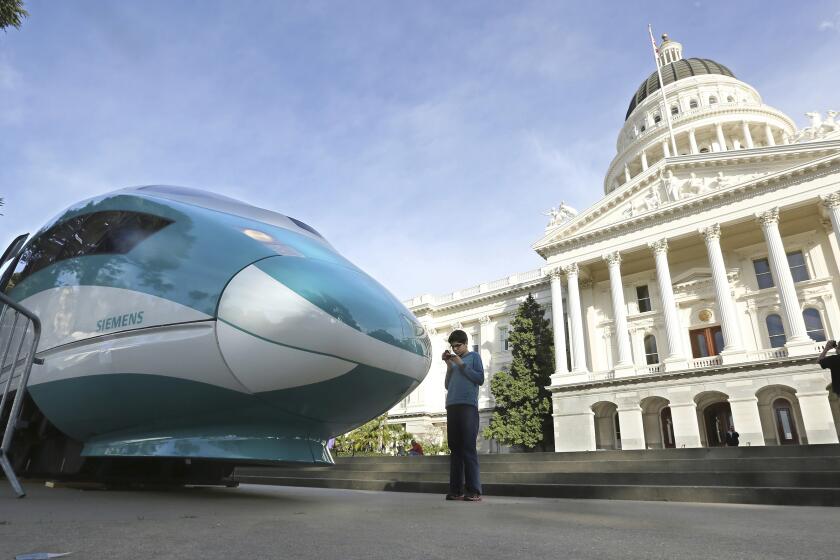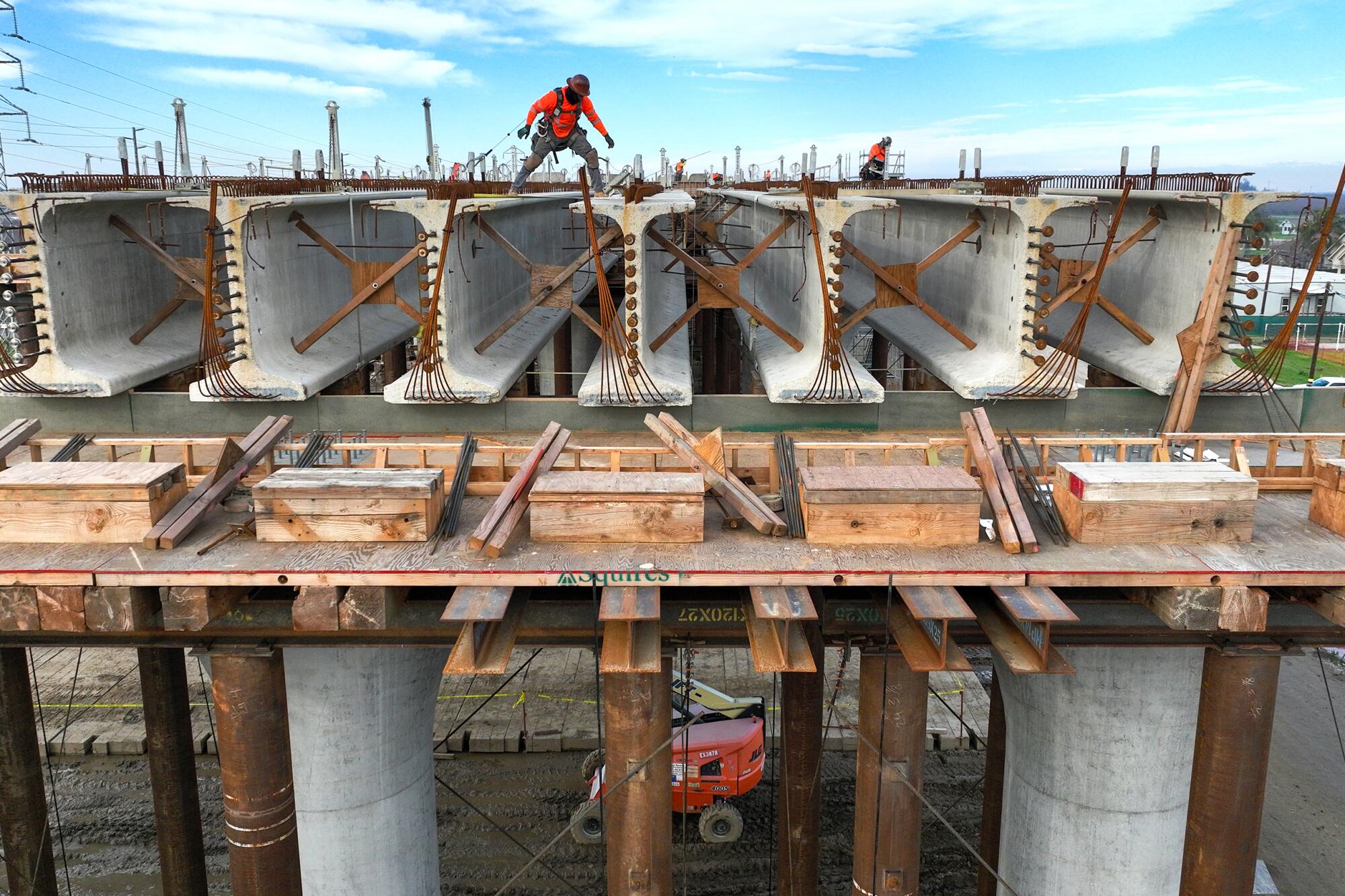
- Share via
FRESNO, Calif. — The piling rig was in position, ready to drive a concrete pillar 40 feet into the ground. Just beyond the rig on this winter afternoon, trucks and cars continued streaming down State Road 198 in Hanford, separated from the construction site by white dividers.
Then, the pile-driving began. Foot by foot, the rig’s hammer slammed the pillar into the ground with the rhythmic beat of a metronome. With every blow, the ground shook and exhaust spewed. The beam would be one more in a network of pillars pounded deep into the earth to create the foundation for a high-speed rail line that in a matter of years will glide along tracks above the state highway, launching a new era in California’s Central Valley.
From earth-moving equipment to heavy trucks ferrying massive beams and bulldozers clearing piles of debris, construction related to California’s high-speed rail project is evident across the San Joaquin Valley. Farther north, crews worked atop a viaduct that will carry the high-speed line above existing freight tracks that cut across the state north to south. And in Fresno’s Chinatown, restaurant and retail owners eagerly served a steady influx of construction workers, engineers and electricians, part of a broader transformation of the city’s downtown and economic prospects.
California’s high-speed rail may still be a matter of carping debate in some political circles, but it’s fast becoming a reality for residents of the Central Valley. This heavily farmed region — historically separated from Los Angeles, San Francisco and the California coast by both conservative politics and physical distance — is first in line to benefit from an infrastructure project being built with tens of billions of dollars in state and federal funding.
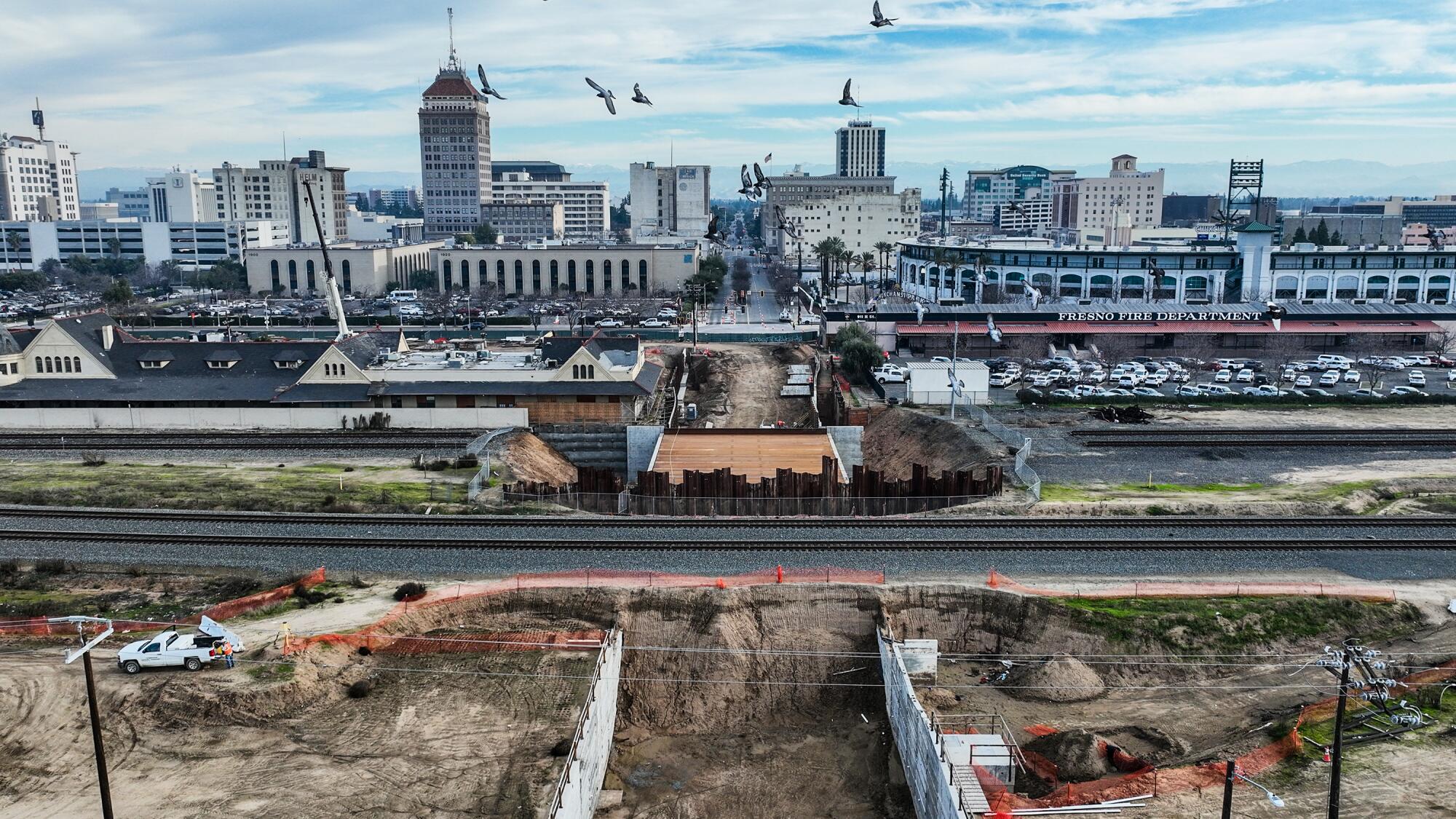
The 171-mile stretch of rail running between Merced and Bakersfield could be operational as early as 2030, with testing of the bullet trains slated to begin in 2028, according to the High-Speed Rail Authority. The project has created more than 12,000 construction jobs, with 70% of those workers coming from the Central Valley. Authority officials cited 25 active construction sites, with the Kings/Tulare station outside Hanford being the largest. The authority is closing in on finishing 22 miles of rail north of Shafter, set to be the first segment of the rail line completed.
In December, the Biden administration awarded the authority a $3.1-billion grant, the authority’s biggest award to date. The funds will go toward purchase of six electric trains for testing and use, design and construction of the Fresno station and designs for the Merced and Bakersfield extensions.
Residents and local officials acknowledge there has long been dissent over the project. Some of the region’s big farm interests have mounted fierce opposition, rallying conservative lawmakers to their cause.
When state voters first approved a bond issue for the project in 2008, rail officials estimated the entire 500-mile system from Los Angeles to San Francisco would cost $33 billion and be operational by 2020. That start date has repeatedly pushed back amid legal challenges, delayed environmental reviews and mismanaged contracts. And with those delays, estimated costs for the full project have spiraled to more than $110 billion. The San Joaquin Valley segment alone is now priced at $32 billion.
Still, local officials say the tenor of the conversation has changed as more jobs are created and structures go up.
When Interstate 5 was conceived in the mid-20th century as a major transportation corridor connecting California from north to south, the Central Valley’s interests were not part of the equation. The route skirts the valley’s rural western edge, and its major population centers — Fresno, Modesto, Bakersfield — were left out. In contrast, the high-speed rail line will cut through the heart of the valley, and Fresno and Bakersfield are key transportation hubs along the route.
The first operating segment of the high-speed line will run from Bakersfield in the south to Merced in the north. The vision is to ultimately extend service to Los Angeles and San Francisco. But even before those planned expansions, the rail line will intersect with existing passenger rail in Merced and a satellite bus network in Bakersfield to create more seamless nonauto travel options.
Local officials believe that connectivity will open all sorts of horizons: making it easier for people to live inland, where housing is relatively affordable, and still work on the coast. Access to jobs — particularly nonfarm jobs — and top-notch colleges will expand. And a region notably lacking in hospitals and healthcare professionals will have more options.
“To say I’m excited is an understatement,” said Fresno Mayor Jerry Dyer, a Republican. “High-speed rail is a game-changer for Fresno and the Central Valley in many ways. No. 1, it will reconnect Fresno and the entire valley with the rest of the state and connect us with the California economy.”
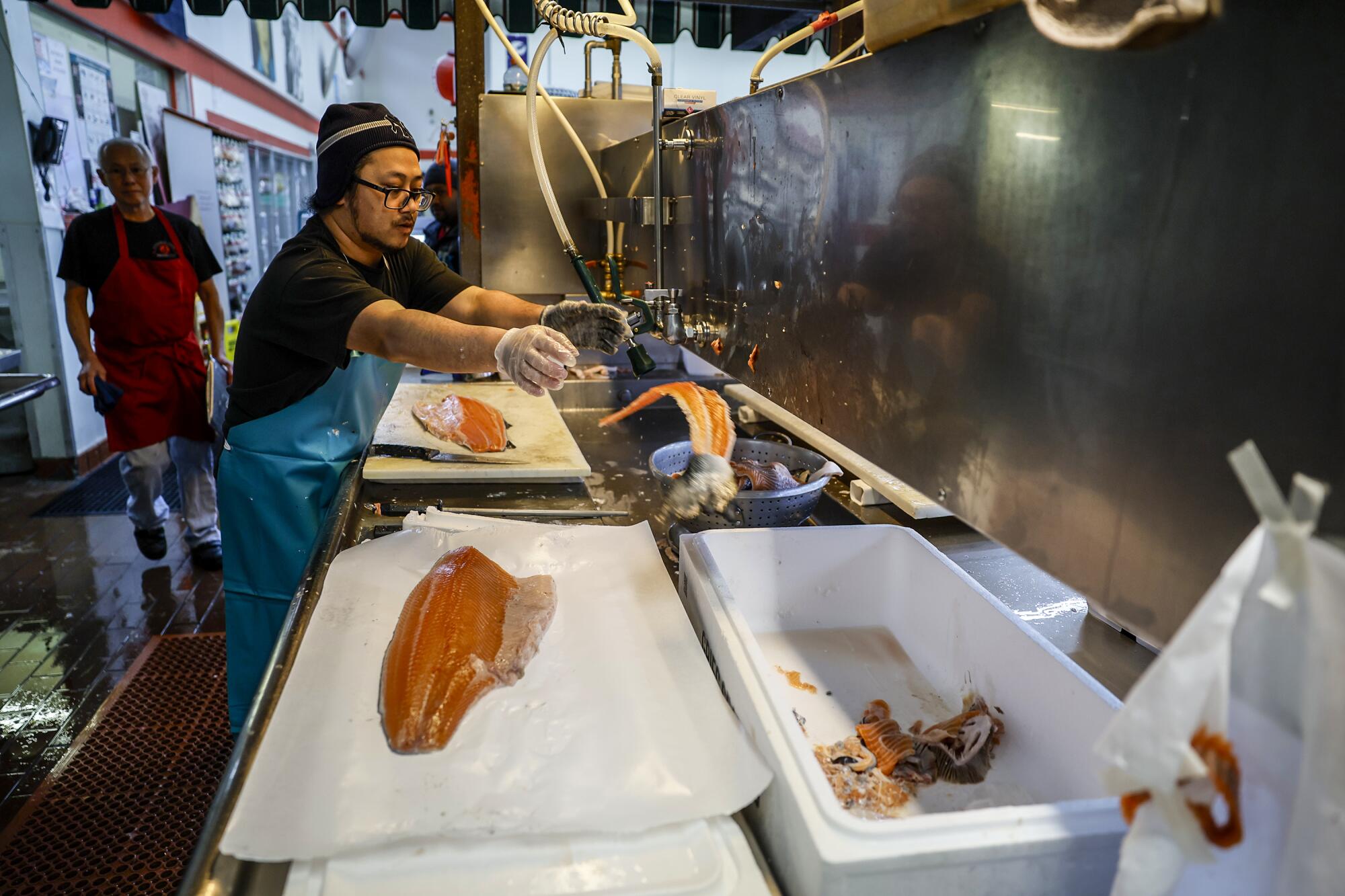
In Fresno’s Chinatown, there is a rich history of diverse communities driven together by redlining policies.
Dating to the 1860s, Chinese migrants working on the freight railways were forced west of the tracks. Pretty much anyone who was not white migrated to what became Chinatown, and a thriving community evolved as people from Africa, the Philippines, Mexico and Japan settled in the area. All that began to unravel in the 1960s when urban renewal projects brought freeway construction that severed Chinatown from the rest of the city and forced mass displacement of residents. Businesses shuttered, buildings were abandoned, and those who remained lived amid blight.
Central Fish Co., opened in 1950, is one of the longest-standing businesses that remain. Owner Morgan Doizaki, who took over the shop from his parents, is a big proponent of the rail project. He, along with other business and property owners, formed the nonprofit Chinatown Fresno Foundation to support the rail line and advocate for the neighborhood’s inclusion in Fresno’s transformation. The Fresno station will be built on the site of the city’s historic depot center in downtown, and related renovations involving roads and walkways will connect commuters to Chinatown.
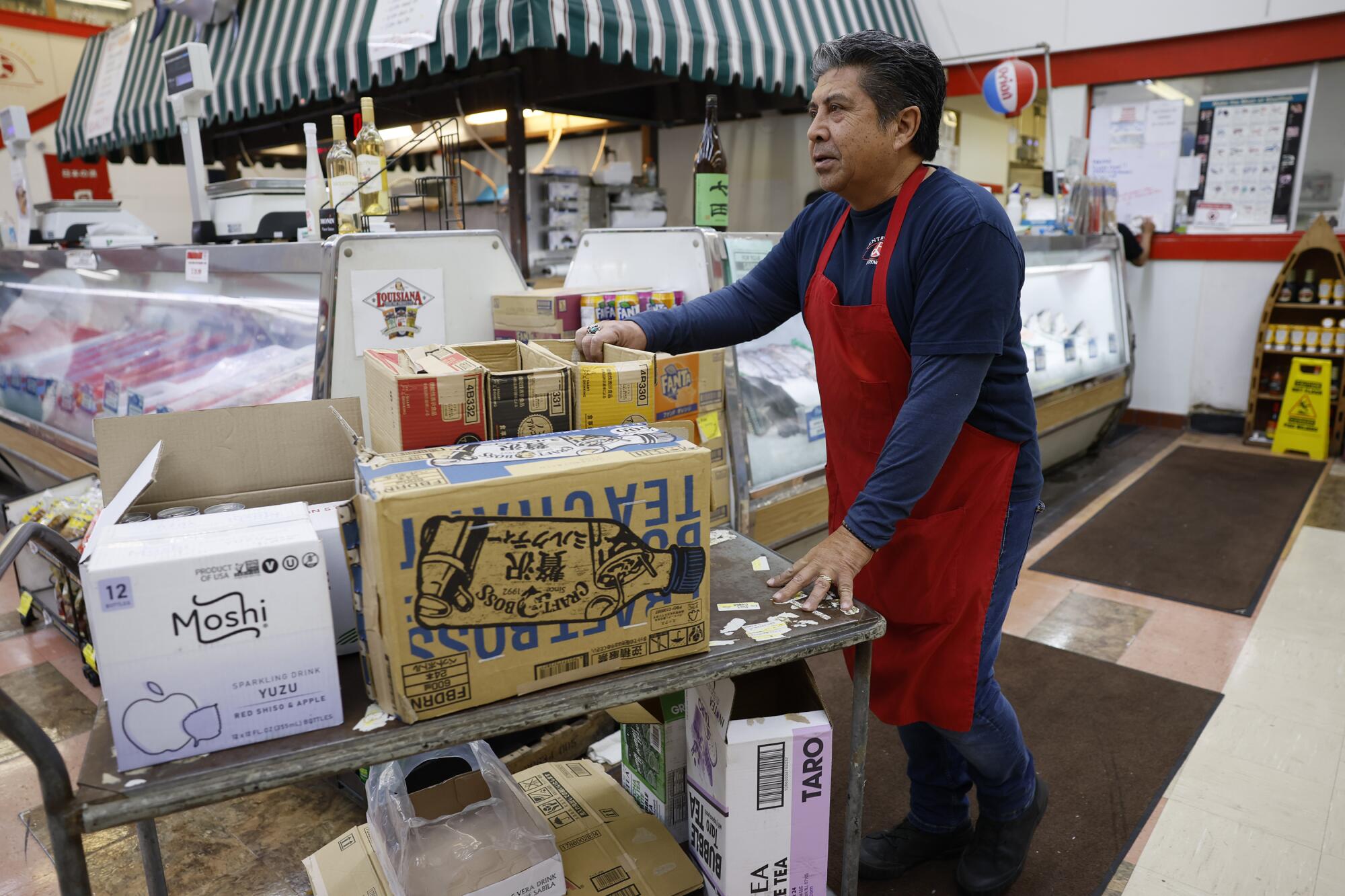
The massive reconstruction is not without challenges. Carniceria y Taqueria La Nueva Reyna, which has served traditional Mexican dishes on Tulare Street for more than a decade, has put up large, colorful banners to let people know they remain open. To get inside, patrons must navigate bright orange netting, maneuvering around missing sidewalks and large machinery. While they have lost some old customers, owner Reyna Cruz said, they’ve also gotten new business from construction workers stopping by for lunch and beverages on their breaks. “There are good times and bad times,” she said as workers streamed in to buy sodas on a Monday afternoon.
Central Fish Co. customers have to navigate a maze of road closures that sometimes box in the store, Doizaki said. Still, he is hopeful. In 2019, he purchased a building in Chinatown that he envisions turning into an apartment and retail complex.
“When the time is right, we’ll be in a position to capitalize on the state’s largest project ever coming into our backyard,” he said. “It’s like a gift.”
Orlando Viloria, who works for Doizaki, is also excited by the rail line’s promise. He envisions day trips to Los Angeles to see his family and them zipping up to see him. “That’s always been my dream,” he said. “I just can’t wait.”
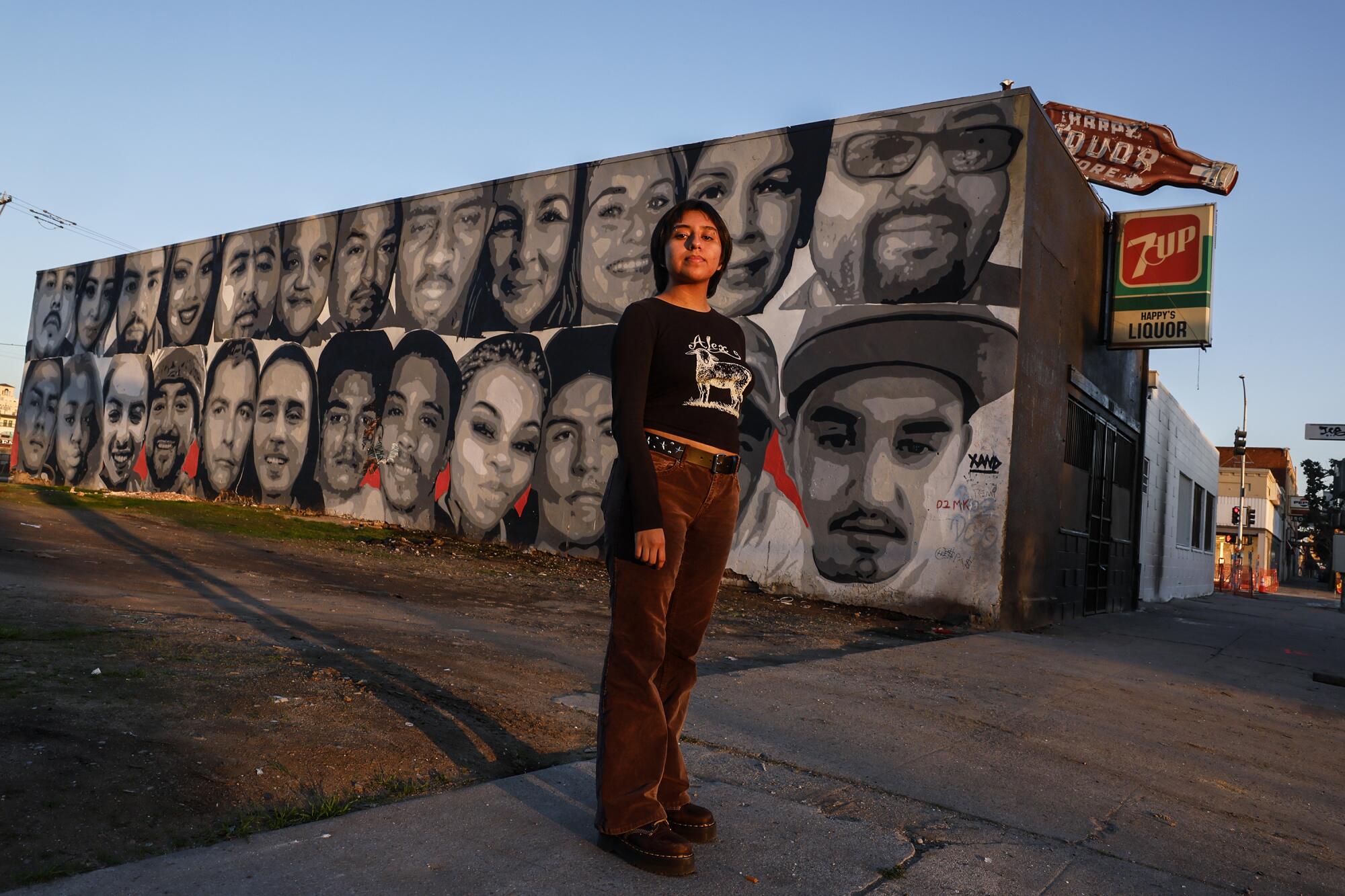
Fresno City College student Domaris Cid is among the younger residents who see the chance to expand their educational options while still living at home. She said she loves her hometown for its hiking trails and riverfront parks along the San Joaquin River but finds the dearth of diverse educational institutions limiting.
“It kind of sucks how I would have to move out of the valley to ... have an education that I want,” said Cid, 18. The high-speed rail, she said, could give her access to UC Merced or UC Berkeley to continue her political science studies. “I wouldn’t have to leave a place I really do like.”
Not everyone in Fresno is a fan. Cid’s aunt, Marina Covarrubias, is among those who worry that becoming more connected to the rest of California will mean more people looking to buy homes in Fresno, which in turn could drive up housing costs and price out local folks. “I don’t think it’s going to be the bigger cities complaining about it,” Covarrubias said. “It’s going to be us.”
Mayor Dyer acknowledged that accommodating the state’s first high-speed rail project comes with steep learning curves, not to mention the disruption and noise of construction. Later this year, he said, he plans to visit Tokyo to understand how leaders in Japan revamped cities to take advantage of high-speed rail so he can ensure Fresno becomes a “destination point.”
“Short-term pain, long-term gain,” he said. “We’re the largest metropolitan area in all of Central California, so it’s largely our responsibility to lead the way.”
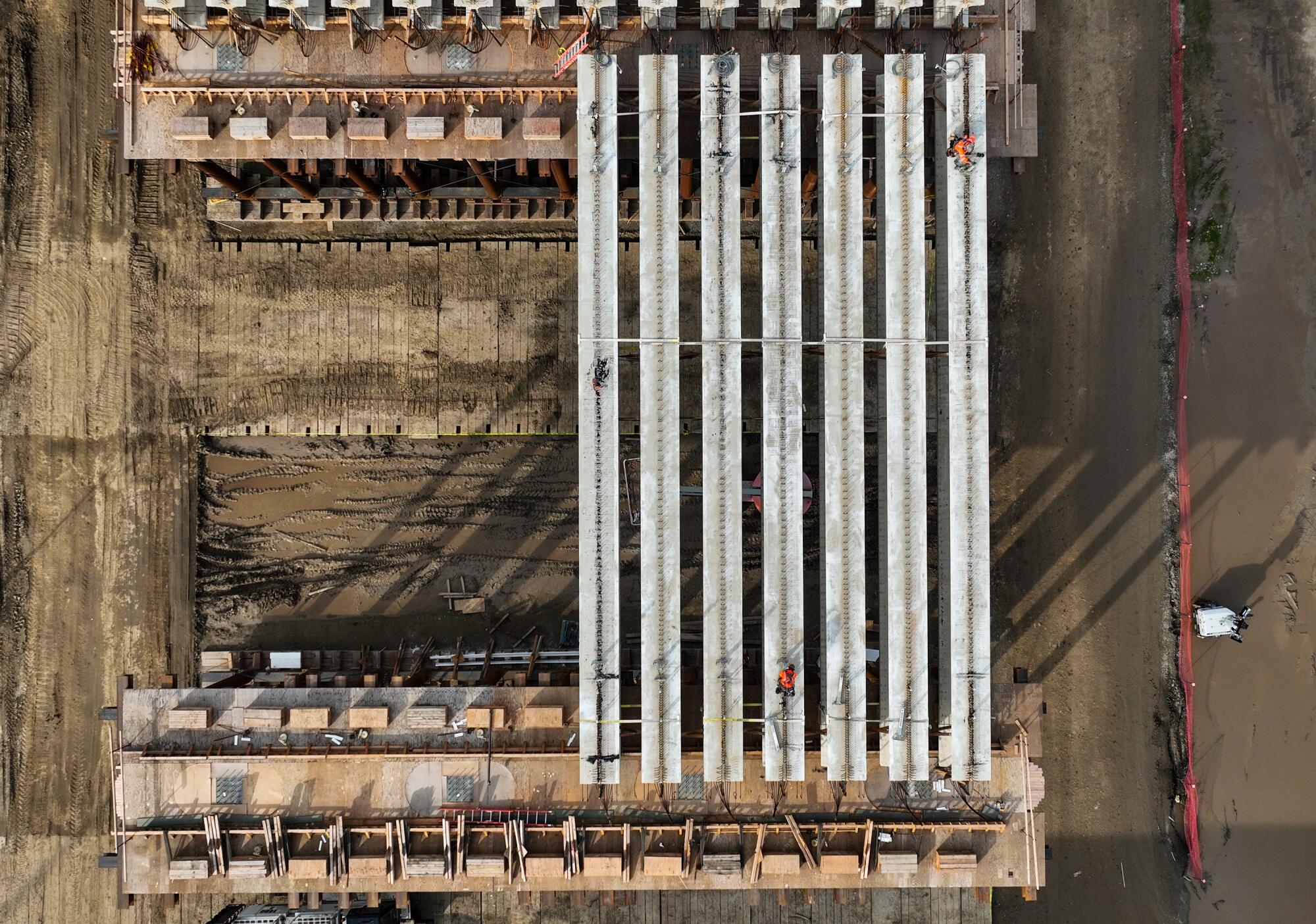
Bakersfield vice mayor Andrae Gonzales remembers the chorus of opposition when the state first proposed high-speed rail. Many area farmers objected to the state using eminent domain to buy up land for the route.
But as the pile-drivers pound away and the project takes shape, Gonzales said, “What I’m hearing now is that high-speed rail can be an asset and benefit to our region.”
President Biden delivered a Christmas gift for California: Billions of dollars to help build high-speed rail.
A majority of California voters agree, viewing the high-speed rail favorably, according to a 2022 poll by UC Berkeley’s Institute of Governmental Studies and The Times. The poll found that 56% of voters support the state’s current plan.
In Bakersfield, the high-speed rail station is central to the city’s revitalization plans for a downtown core left moribund by suburban flight. For nearly a decade, city leaders have sought to bring it back to life.
They see an opportunity to increase housing stock near the station and create jobs around the rail operation — and at the same time to markedly ease commutes for the many residents who live in Bakersfield and work in Los Angeles, Gonzales said. Once the Bakersfield station is complete, the authority intends to establish it as a regional hub that will have specialized bus service to Los Angeles until the rail system is extended.
As a “pro-growth, pro-development and pro-business kind of person,” Hanford vice mayor Mark Kairis said he, too, sees high-speed rail’s potential as an economic driver for his town of 58,000, with more people willing to call Hanford home as it becomes embedded in the high-speed line’s path.
“The train is coming by and we have an option either to get on or stand by and watch it go on,” Kairis said. “We all know it’s coming. It’s kind of exciting to see that, and see what that might bring for us.”
More to Read
Sign up for Essential California
The most important California stories and recommendations in your inbox every morning.
You may occasionally receive promotional content from the Los Angeles Times.
